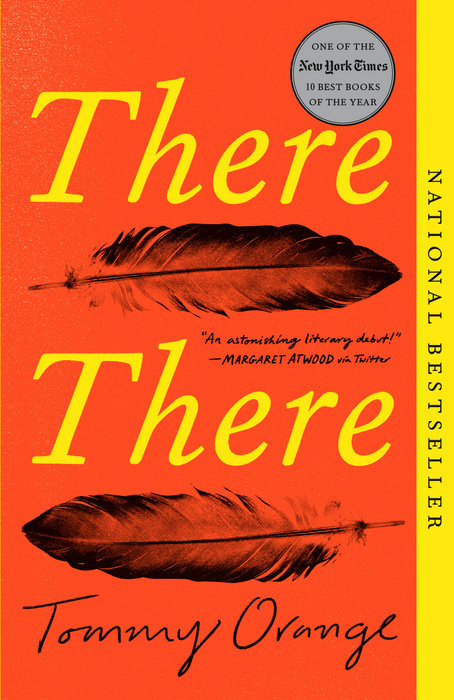
THERE THERE
Tommy Orange’s shattering novel follows twelve characters from Native communities: all traveling to the Big Oakland Powwow, all connected to each other in ways they may not yet realize. Together, this chorus of voices tells of the plight of the urban Native American—grappling with a complex and painful history, with an inheritance of beauty and spirituality, with communion and sacrifice and heroism.
Hailed as an instant classic, There There is at once poignant and laugh-out-loud funny, utterly contemporary and always unforgettable.
Tommy Orange’s shattering novel follows twelve characters from Native communities: all traveling to the Big Oakland Powwow, all connected to each other in ways they may not yet realize. Together, this chorus of voices tells of the plight of the urban Native American—grappling with a complex and painful history, with an inheritance of beauty and spirituality, with communion and sacrifice and heroism.
Hailed as an instant classic, There There is at once poignant and laugh-out-loud funny, utterly contemporary and always unforgettable.
- Vintage
- Paperback
- May 2019
- 304 Pages
- 9780525436140
About Tommy Orange
Tommy Orange is a graduate of the MFA program at the Institute of American Indian Arts. An enrolled member of the Cheyenne and Arapaho Tribes of Oklahoma, he was born and raised in Oakland, California.
Praise
One of the Best Books of the Year: The Washington Post, NPR, Time, O, The Oprah Magazine, The Dallas Morning News, GQ, Entertainment Weekly, BuzzFeed, San Francisco Chronicle, The Boston Globe
Winner of the PEN/Hemingway Award
Winner of the National Book Critics Circle John Leonard Prize
Winner of the Center for Fiction First Novel Prize
“Powerful. … There There has so much jangling energy and brings so much news from a distinct corner of American life that it’s a revelation.” —The New York Times
“An astonishing literary debut.” —Margaret Atwood
“Pure soaring beauty.” —The New York Times Book Review
Discussion Questions
1. The prologue of There There provides a historical overview of how Native populations were systematically stripped of their identity, their rights, their land, and, in some cases, their very existence by colonialist forces in America. How did reading this section make you feel? How does the prologue set the tone for the reader? Discuss the use of the Indian head as iconography. How does this relate to the erasure of Native identity in American culture?
2. Discuss the development of the “Urban Indian” identity and ownership of that label. How does it relate to the push for assimilation by the United States government? How do the characters in There There navigate this modern form of identity alongside their ancestral roots?
3. Consider the following statement from page 9: “We stayed because the city sounds like a war, and you can’t leave a war once you’ve been, you can only keep it at bay.” In what ways does the historical precedent for violent removal of Native populations filter into the modern era? How does violence—both internal and external—appear throughout the narrative?
4. On page 7, Orange states: “We’ve been defined by everyone else and continue to be slandered despite easy-to-look-up-on-the-internet facts about the realities of our histories and current state as a people.” Discuss this statement in relation to how Native populations have been defined in popular culture. How do the characters in There There resist the simplification and flattening of their cultural identity? Relate the idea of preserving cultural identity to Dene Oxendene’s storytelling mission.
5. Tony Loneman’s perspective both opens and closes There There. Why do you think Orange made this choice for the narrative? What does Loneman’s perspective reveal about the “Urban Indian” identity? About the landscape of Oakland?
6. When readers are first introduced to Dene Oxendene, we learn of his impulse to tag various spots around the city. How did you interpret this act? How does graffiti culture work to recontextualize public spaces?
7. Discuss the interaction between Opal Viola Victoria Bear Shield and Two Shoes that occurs on pages 50–52. How does Opal view Two Shoes’s “Indianness”? What is the import of the Teddy Roosevelt anecdote that he shares with her? How does this relate to the overall theme of narrative and authenticity that occurs throughout There There?
8. Describe the resettlement efforts at Alcatraz. What are the goals for inhabiting this land? What vision does Opal and Jacquie’s mother have for her family in moving to Alcatraz?
9. On page 58, Opal’s mother tells her that she needs to honor her people “by living right, by telling our stories. [That] the world was made of stories, nothing else, and stories about stories.” How does this emphasis on storytelling function throughout There There? Consider the relationship between storytelling and power. How does storytelling allow for diverse narratives to emerge? What is the relationship between storytelling and historical memory?
10. On page 77, Edwin Black asserts, “The problem with Indigenous art in general is that it’s stuck in the past.” How does the tension between modernity and tradition emerge throughout the narrative? Which characters seek to find a balance between honoring the past and looking toward the future? When is the attempt to do so successful?
11. Discuss the generational attitudes toward spirituality in the Native community in There There. Which characters embrace their elders’ spiritual practices? Who doubts the efficacy of those efforts? How did you interpret the incident of Orvil and the spider legs?
12. How is the city of Oakland characterized in the novel? How does the city’s gentrification affect the novel’s characters? Their attitudes toward home and stability?
13. How is femininity depicted in There There? What roles do the female characters assume in their community? Within their families?
